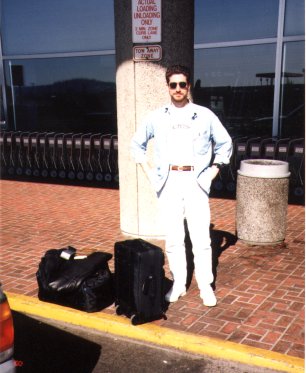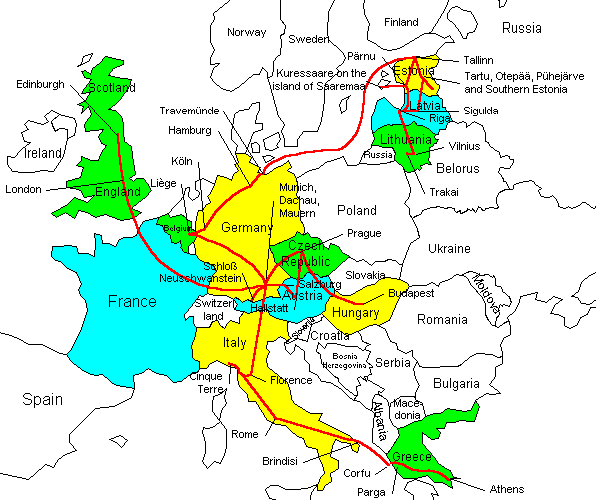August 8, 1994. We have email. We have email! I’ll tell you about more about that in a minute.
Foreign countries, especially non-Western foreign countries, can be confusing. I am in Tallinn, Estonia, which is perhaps the most Westernized city in all of the former Soviet Union. A great many people here speak English or German. Nonetheless, the first few days can be like a trip to the moon. After that, things slowly begin to make sense.
Let me tell you a little of what I have seen here. Although Tallinn is the crumbling and decrepit victim of 50 years of Soviet occupation, it has some truly outstanding features. First is a medieval old town unrivaled in all of Europe. Despite a bombing raid by the Soviet army in 1944 that destroyed 40% of the housing in Tallinn, the old city is very much intact. Today the old city is alive with the sound of hammers and workmen, restoring many of the buildings that have fallen into disrepair. When the state owned all the buildings, nothing ever got fixed. Now that they are in private hands, repairs are going on everywhere.
Another outstanding feature of Tallinn today is the opportunity. Everywhere entrepreneurs are grabbing their new-found freedom and turning a buck with it. This is not to say that the people here are wealthy; most, in fact, are very poor and have a real problem stretching their income to meet their expenses. A free market economy has created very distinct upper and lower classes. You can see it on the street: Estonian Yuppies make deals on cell-phones from their Mercedes, retired pensioners try to get by on US$20 a month.
Baby, You Can Drive My Car
I am fortunate that I have had quite a bit of help from an Estonian native. With his assistance, I have managed to buy a car — a 1982 BMW — and get it registered and insured. I do not recommend you try this unless you absolutely have to. If you think the California DMV is bad, the Estonian Autoregistri is like some bizarre mating of a Russian breadline and a Turkish Bazaar. You have absolutely no idea what is going on, but there are a dozen different forms to complete and several different lines to wait in. On top of this, you must have Estonian residency papers to register a car here. Lacking these, I had to get special permission from the head of the Estonian automobile registry and the head of the local registry office before I could even begin the process. Registering involved paying three different taxes — for what, I have no idea — and waiting for several hours sandwiched among a bunch of fat, sweaty Russians. But it’s done, and I’m mobile. All that is left is to install a hefty alarm; car theft is a big problem here.
Ricki, Don’t Lose That Number
Back to the email. The phones in Estonia — how can I put it? — suck bad. There are three kinds of common phones in Estonia. First are the telephones you find in homes and hotels. These are suitable for voice communications, but more or less useless for data.
The second are common payphones. These are ubiquitous gray metal booths on which is stenciled the word “Telefon”. They were made to accept rubles but, since the phone company does not have the money to convert them, they can now be used for free. Like regular telephones, they are suitable for local voice calls, but useless for anything else.
The third kind of phones are the new, orange payphones labeled Eesti Telefon. These phones use a special phone card that you can usually purchase somewhere nearby. A 16 krooni card (about US$1.30) will give you about 2 hours of local calling time. However, trying to connect your notebook PC to an email service at a payphone is not the easiest thing in the world. Here’s the trick. First, you must have an acoustic coupler for your modem. Mine came from Unlimited Systems in San Diego, California; they make good equipment and I recommend them highly. Next, find a phone with nearby seating. My favorite so far is in the lobby of the Hotell Mihkli on Endla street. It is installed right next to a sofa. You can sit down with your notebook while you transmit. Of course, this got me some amazed looks from the hotel staff who told me, in their halting English, that this is the first time they have seen a computer used on a phone. Lastly, although these phones seem to dial using the same tones as American phones, they do not recognize the tones when they are played into the receiver by a computer. You will have to tell your communications program to connect as it normally would, but then dial the number manually. This seems to work.
CompuServe has a local access number in Tallinn. If all you need is email, CompuServe is a good choice here. Access is provided through SprintNet, a computer network owned by U.S. Sprint. Connecting via SprintNet is an adventure in itself, so let me give you this rule of thumb: if you plan to travel and use CompuServe for email, make sure you get a copy of the access telephone numbers and all instructions for connecting before you leave your home country. Oddly, my contact here was surprised and happy to hear that CompuServe has a local access number in Tallinn. His company had been calling Germany to connect.
One Bourbon, One Scotch, and One Beer
Every day in Estonia is a new opportunity to drink alcohol. Drinking seems to be the national sport. A bottle of Finlandia Vodka that costs US$29.00 in Finland, costs US$6.00 here. Local vodka can be had for about US$3.00 a bottle. The “most popular drink in Estonia,” according to my unofficial sources, is called Gin Long Drink. It is gin and tonic in a can, available for 8 or 9 krooni (about US$0.75) at every restaurant, bar, grocery store, street kiosk, fast food joint and bus stop in Tallinn. Anywhere you can buy a candy bar or a Coke, you can buy a Gin Long Drink. It’s not bad, by the way.
The national beer, Saku, comes in several different varieties — all of them mediocre. And, so far, all of the food here is equally mediocre. A Brit whom I met at lunch yesterday told me “You don’t come here for the food.” Basically, there seems to be one meal in Estonia, with slight variations. It consists of a plate of french fries with sliced tomatoes and cucumbers on one side and a slab of meat — pork beef or chicken — on top of the fries. In many places they will add some form of cabbage salad or fried vegetables to this. I have had this meal in different places almost every day so far. I am surprised, though, because I always I am ordering something different. I think the name for this meal literally translates to “gut bomb.”
Hit the Road, Jack
August 12, 1994. Tartu, Estonia is 200 km southeast of Tallinn and home to the most well known university in Estonia, founded in 1632. Now that I have registered, insured and put an alarm on my car, I am beginning to see this country. I am staying for a couple of days in the home of a talkative Estonian woman 2 km north of Tartu. Her home is remarkably clean and well maintained, and her English is unusually difficult to understand. She is friendly and hospitable, but talks like a machine-gun. Next month she goes back to the university for her second semester of much-needed English lessons.
Back in the USSR
This morning I met with the networking manager of the University to discuss Estonia’s connections to the Internet. You see, three years ago there was no Internet in Estonia. Three years ago you would have to get official permission well in advance just to use a photocopier which, naturally, were kept locked and well guarded. This was to prevent the spread of subversive ideas. Today, you can walk into any of a dozen buildings around the town square in Tartu and download the U.S. constitution or explicit nude photographs or instructions for building an atomic bomb. All the world’s “subversive” ideas are now so ripe they are falling from the trees.
Three years ago, Western visitors were not allowed to stay overnight in Tartu, presumably to keep them from spying on the nearby airfield, which was the largest in the Soviet Union. Today, there are many new hotels and restaurants in Tartu, and the airfield is abandoned.
I have already met several Americans who are here to consult with the Estonian local governments about the nature of democracy. One couple gave me a tour of the Supreme Court building and the Tartu History Museum. At night we went to a local restaurant/bar/casino/disco and talked about Estonia, while the college students danced and smoked cigarettes.
Enjoy the Silence
August 14, 1994. At a lake called Puhajarv, just outside of the small town of Otepaa, about 60 km southeast of Tartu, there is a small pub and inn called Kolga-Oru. The inn is small, but the rooms are modern and comfortable. This is the nicest hotel I have found so far. The pub plays Irish music and serves Guinness on tap. Kolga-Oru was built by an Irishman who came for a visit and was so taken with the place, he never went back; I don’t blame him. Yesterday I rented a rowboat for 15 krooni (about US$1.20), paddled out into the lake and relaxed in the sun for an hour. This place is quiet, wooded and peaceful. I’m beginning to really enjoy this trip.
Copyright © 1994, Kenn Nesbitt

![[Previous]](https://poetry4kids.com/travel/PREVBTN.gif)
![[Next]](https://poetry4kids.com/travel/NEXTBTN.gif)

 “Life is too rich to watch it slip by from inside your cubicle.“..and with those words, Kenn leads off his narrative of a break from the life of a computer consultant in Portland Oregon to explore eastern Europe. Armed with a notebook computer, a few writing assignments (including these pages) and a curiosity for culture and a new world, Kenn travels and sends back brief glimpses into his experience for us to share.“[-webmaster]
“Life is too rich to watch it slip by from inside your cubicle.“..and with those words, Kenn leads off his narrative of a break from the life of a computer consultant in Portland Oregon to explore eastern Europe. Armed with a notebook computer, a few writing assignments (including these pages) and a curiosity for culture and a new world, Kenn travels and sends back brief glimpses into his experience for us to share.“[-webmaster]





